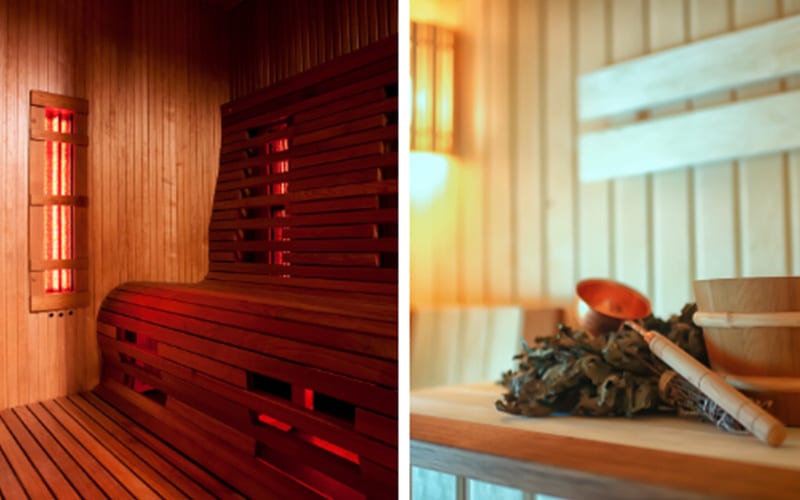An infrared sauna may look similar to a traditional sauna, and they both cause you to sweat and increase your heart rate. However, that is where the similarities end. The biggest differentiator is on how they work. A traditional sauna heats up the air around you whereas an infrared sauna utilizes heat being emitted from the built-in infrared heaters, located on the sides and the top of the unit. So, while there are obvious differences between the two saunas here are the not so obvious ones:
An Infrared Sauna is Heating Your Body Directly, Not The Air
Traditional saunas heat up the air around you as high as 195 degrees fahrenheit. As the air temperature increases, so does your body temperature. However, infrared saunas use infrared panels and emit infrared light that humans cannot see. That light is absorbed by the skin and our body is heated from the inside out. “These saunas use infrared panels instead of conventional heat to easily penetrate human tissue, heating up your body before heating up the air,” explains physical therapist, Vivian Eisenstadt. Simply put, you’re heating your body from the outside in.
You Get the Benefits at a Lower Temperature
Unlike traditional saunas that must be heated to 160˚F and 200˚F to reap the benefits, infrared saunas typically stay between 110˚F and 150˚F. Due to how infrared saunas heat your body up, it causes deeper tissue penetration, you can work up a more vigorous sweat at a lower temperature, making infrared saunas more tolerable. This is especially important to those who are sensitive to heat or overwhelmed by the higher temperatures of traditional saunas. Due to saunas producing dry heat, users often find infrared saunas are less stifling than the humidity associated with steam rooms.
Tolerable for longer sessions
As mentioned above, infrared saunas are more tolerable due your body reacting at a lower temperature. Sauma bathers can often tolerate longer sessions due to the air around you not being heated. A 30 – 60 minute session is more than achievable for infrared sauna users.
Benefits of both Infrared Sauna and Traditional Sauna
In August 2018, the Mayo Clinic released a study on sauna benefits, including:
- Lowered blood pressure
- Decreased risk of hypertension, fatal heart disease, stroke and cognitive decline
- Improved vascular function and inflammation levels
- Boost immune responses, resulting in fewer common colds and the flu
- Pain relief from conditions like osteoarthritis, rheumatoid arthritis, and fibromyalgia
- Increase in athletic performance
- Production of feel-good hormones like endorphins, which boost moods and relieve stress
Clinical studies have found that infrared saunas may also help treat chronic health problems such as:
- High blood pressure (due to the infrared light therapy)
- Headaches
- Type 2 diabetes
- Better sleep and relaxation
- Detoxification
- Weight loss
- Relief from stiff, tight, or sore muscles
- Clear and tighter skin
- Improved sleep
- Relaxation
- Relief from joint pain such as arthritis
- Improved circulation
- May help for people with chronic fatigue syndrome
- Congestive heart failure
- Dementia and Alzheimer’s
Infrared saunas speed up wound healing by promoting faster cell regeneration and tissue growth.They also contribute to a person’s well being by helping them relax and a number of other benefits. While either traditional saunas or infrared saunas both provide the body with similar benefits, it is clear that infrared saunas are superior.
